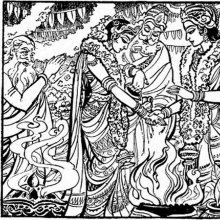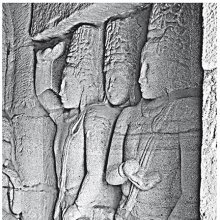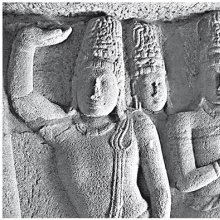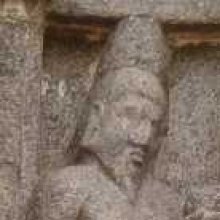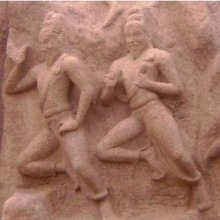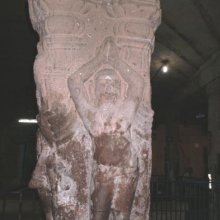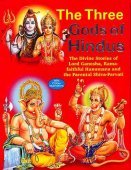Sage: 4 definitions
Introduction:
Sage means something in Hinduism, Sanskrit, biology. If you want to know the exact meaning, history, etymology or English translation of this term then check out the descriptions on this page. Add your comment or reference to a book if you want to contribute to this summary article.
Images (photo gallery)
(+26 more images available)
In Hinduism
Ayurveda (science of life)
Source: INSA Digital Repository: Caraka’s Approach to KnowledgeSages are exceptional individuals who personify profound knowledge, long experience, truthfulness, freedom from passion and a noble character (Charaka Samhita, verse 11.18-19). They could always be counted upon for counsel, to dispel one’s doubts and provide a means to exact knowledge. This is especially true for a physician who is faced with difficult issues in diagnosis and treatment for which the standard texts and his own resources of knowledge may not provide the answers

Āyurveda (आयुर्वेद, ayurveda) is a branch of Indian science dealing with medicine, herbalism, taxology, anatomy, surgery, alchemy and related topics. Traditional practice of Āyurveda in ancient India dates back to at least the first millenium BC. Literature is commonly written in Sanskrit using various poetic metres.
Natyashastra (theatrics and dramaturgy)
Source: Shodhganga: Elements of Art and Architecture in the Trtiyakhanda of the Visnudharmottarapurana (natya)Sages (in Indian dramas) should be presented as “calm and brave”, as dictated by the Dhīroddhata classification of Heroes (nāyaka), according to the Viṣṇudharmottarapurāṇa, an ancient Sanskrit text which (being encyclopedic in nature) deals with a variety of cultural topics such as arts, architecture, music, grammar and astronomy.—In the Viṣṇudharmottarapurāṇa, it is narrated that Sages should be dhīrapraśānta i.e., calm and brave.

Natyashastra (नाट्यशास्त्र, nāṭyaśāstra) refers to both the ancient Indian tradition (shastra) of performing arts, (natya—theatrics, drama, dance, music), as well as the name of a Sanskrit work dealing with these subjects. It also teaches the rules for composing Dramatic plays (nataka), construction and performance of Theater, and Poetic works (kavya).
Shilpashastra (iconography)
Source: Shodhganga: Elements of Art and Architecture in the Trtiyakhanda of the Visnudharmottarapurana (shilpa)Sages are be denoted in the Sanskrit language as Ṛṣis, and follows specific guidelines in the tradition of ancient Indian Painting (citra), according to the Viṣṇudharmottarapurāṇa, an ancient Sanskrit text which (being encyclopedic in nature) deals with a variety of cultural topics such as arts, architecture, music, grammar and astronomy.—The personalities like [e.g., Sages—ṛṣis], [...] are to be drawn to project them as noble and polite. It is stated that the sage should posses matted hair on their heads. Thus the Viṣṇudharmottarapurāṇa establishes the fact that even in the pictures; the people belonging to different class and profession [e.g., Sages] were projected with specific attire so that general people can equate the picture with the practical character.

Shilpashastra (शिल्पशास्त्र, śilpaśāstra) represents the ancient Indian science (shastra) of creative arts (shilpa) such as sculpture, iconography and painting. Closely related to Vastushastra (architecture), they often share the same literature.
Biology (plants and animals)
Source: Google Books: CRC World Dictionary (Regional names)1) Sage in English is the name of a plant defined with Artemisia dracunculus in various botanical sources. This page contains potential references in Ayurveda, modern medicine, and other folk traditions or local practices It has the synonym Oligosporus condimentarius Cass. (among others).
2) Sage is also identified with Lantana bahamensis It has the synonym Lantana x bahamensis f. albiflora Moldenke (etc.).
3) Sage is also identified with Lantana camara It has the synonym Lantana melissifolia Sol. (etc.).
4) Sage is also identified with Lantana demutata.
5) Sage is also identified with Lantana involucrata It has the synonym Camara involucrata Kuntze (etc.).
6) Sage is also identified with Salvia officinalis It has the synonym Salvia officinalis Pall..
7) Sage in India is also identified with Acacia concinna It has the synonym Nygae sylvarum-minimae Rumph. (etc.).
8) Sage is also identified with Molineria capitulata It has the synonym Leucojum capitulatum Lour. (etc.).
Example references for further research on medicinal uses or toxicity (see latin names for full list):
· Phytologia (1981)
· Aust. Vet. J., (1989)
· Phytologia (1947)
· South African Journal of Botany (1982)
· Economic Botany (1957)
· Allg. Gartenzeit. (1841)
If you are looking for specific details regarding Sage, for example pregnancy safety, side effects, chemical composition, health benefits, diet and recipes, extract dosage, have a look at these references.

This sections includes definitions from the five kingdoms of living things: Animals, Plants, Fungi, Protists and Monera. It will include both the official binomial nomenclature (scientific names usually in Latin) as well as regional spellings and variants.
See also (Relevant definitions)
Starts with: Cakera, Sage brush, Sage rose, Sage tree, Sage-leaved butterfly bush, Sagebrush, Sagebrush buttercup, Sagebrush mariposa lily, Sagedantan, Sagedapu, Sageddamar, Sager, Sagere, Sageretia henryi, Sageretia thea, Sageri, Sagewood.
Ends with (+72): Adusage, Aka-sasage, Annual bur-sage, Annual bursage, Antelope sage, Austral sage, Bastard-sage, Bastardsage, Beach-sage, Bee sage, Besage, Bettabesage, Bettavesage, Big leaf sage, Big sage, Bisage, Black sage, Blue-sage, Bowley sage, California black sage.
Full-text (+6438): Muni, Rishi, Brahmarshi, Maharshi, Markandeya, Vaishampayana, Gautama, Vasishtha, Atri, Bhrigu, Vyasa, Munindra, Jamadagni, Kratu, Vishvamitra, Kapila, Saptarshi, Yajnavalkya, Pulaha, Kashyapa.
Relevant text
Search found 372 books and stories containing Sage; (plurals include: Sages). You can also click to the full overview containing English textual excerpts. Below are direct links for the most relevant articles:
The Shiva Purana (by J. L. Shastri)
Chapter 34 - The enumeration of Manvantaras < [Section 5 - Umā-Saṃhitā]
Chapter 25 - The planned arrangement of Gautama < [Section 4 - Koṭirudra-Saṃhitā]
Chapter 37 - Devotion to lord Śiva < [Section 4 - Koṭirudra-Saṃhitā]
The Gautami Mahatmya (by G. P. Bhatt)
Chapter 71 - Kapilasaṅgama and other Holy Centres
Chapter 48 - Aśvattha and other Tīrthas
Ramayana of Valmiki (by Hari Prasad Shastri)
Chapter 9 - Sumantra relates a tradition that a son will be born < [Book 1 - Bala-kanda]
Chapter 59 - Vishvamitra seeks the help of the sons of Vasishtha and Mahodeva < [Book 1 - Bala-kanda]
Chapter 12 - Rishyasringa agrees to assist in the sacrifice < [Book 1 - Bala-kanda]
The Padma Purana (by N.A. Deshpande)
Chapter 37 - Sage Āraṇyaka Goes to Viṣṇu’s Heaven < [Section 5 - Pātāla-Khaṇḍa (Section on the Nether World)]
Chapter 255 - The Three Gods Subjected to Test by Bhṛgu < [Section 6 - Uttara-Khaṇḍa (Concluding Section)]
Chapter 1 - A Dialogue between Jaimini and Vyāsa < [Section 7 - Kriyāyogasāra-Khaṇḍa (Section on Essence of Yoga by Works)]
The Skanda Purana (by G. V. Tagare)
Chapter 278 - Greatness of Mūlasthāna (Śūlasthāna) < [Section 1 - Prabhāsa-kṣetra-māhātmya]
Chapter 209 - Glory of Mārkaṇḍeyeśvara (Mārkaṇḍeya-īśvara) < [Section 1 - Prabhāsa-kṣetra-māhātmya]
Chapter 137 - Māṇḍavya Impaled < [Section 1 - Tīrtha-māhātmya]
Pallava period (Social and Cultural History) (by S. Krishnamurthy)
Dressing style of sages, ascetics and priests < [Chapter 4 - Material Culture of the People]
Minor deities, celestials, sages and asuras < [Chapter 3 - Socio-Religious Life]
Coiffure of Men < [Chapter 4 - Material Culture of the People]
Related products
(+23 more products available)
